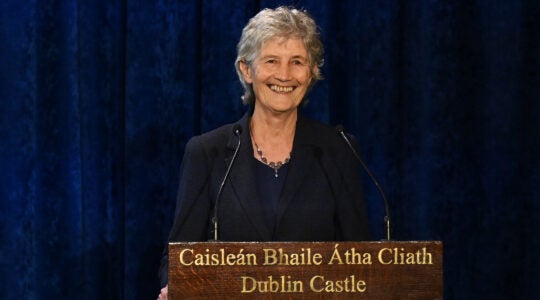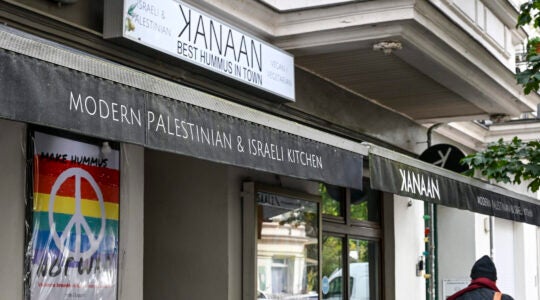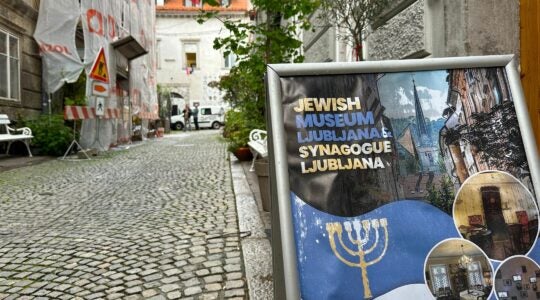
The synagogue in Stupava, Slovakia, is being restored by Jewrope, an NGO dedicated to restoring Jewish cultural life. (Alex Weisler)
My whirlwind tour of Jewish sites in Western Slovakia — tagging along with about two dozen students and faculty from three regional Jewish studies graduate programs — kicked off this morning in Stupava, a sleepy town just outside of Bratislava’s city limits.
Tour organizer Michael Miller, of the Jewish studies graduate program at Budapest’s Central European Univesity, told the group that bypassing Bratislava was a conscious choice.
Just up from Budapest on the Danube, it’s easily accessible by train — unlike the synagogues and cemeteries we plan to visit, which are more remote and require cars or buses.
In Stupava, we visited a synagogue that dates back to 1803 and is believed to be one of the three oldest in Slovakia.
It’s "the only one still to some extent used for Jewish affairs and Jewish events," said Tomas Stern, director of Jewrope, a Slovakian NGO that has made the restoration of Stupava’s synagogue a top priority in its quest to rebuild and sustain Slovakian Jewish cultural life.
[[READMORE]]
Since Jewrope was founded about ten years ago, the Stupava site has undergone extraordinary changes, like a new roof, new windows and restoration of the four central columns that surrounded the synagogue’s biome — an operation that revealed gold leaf and other adornments.
"It was kind of a disaster," Stern said of the synagogue’s appearance before restoration efforts.
Now the site houses Jewish and secular art exhibitions and concerts, and its prime location in the Bratislava suburbs frequently attracts about 150-200 people per event, Stern said.
Stupava’s Jewish community was once estimated to be between 30 and 50 percent of the town’s population — but migration to Bratislava and Vienna caused numbers to drop to 191, or 5 percent of the town’s population, on the eve of the Holocaust in 1940.
Though some Stupava Jews survived the war, the community was absorbed into Bratislava’s larger Jewish structure and the synagogue was never reconstituted, Miller said.
In communist times, the site was used as a warehouse and factory. Now the plan is to use the site to house a sort of genealogical archive for the Jews of western Slovakia — but Stern said that project is likely at least 10 years off.
"The library is a kind of science-fiction story because there is still a lot of work to be done before we can make something like that under this roof," he said.
From my colleague Ruth Ellen Gruber’s extensive work, I know that western Slovakia is chock-full of Jewish landmarks and of innovative restoration efforts aimed at adapting and invigorating shuttered synagogues and holy sites.
But her analysis and tips didn’t prepare for the thrill of seeing a restoration project in action.
This morning, the former men’s section of the Stupava synagogue was home to an art exhibition — gloomy prints of forlorn, ethereal women — while the former women’s section upstairs housed a colorful collection of children’s artwork.
Ten years ago, Stern told us, the walls were collapsing and there was no sign of a mezuzah. Now, the same site is at the nexus of a dedicated NGO’s fight to transforming historic sites into places that are "again alive."
Just outside of the synagogue, a trio of banners lined the fence of the town’s main church, which dominates downtown Stupava. Next to ads for a film festival and zumba fitness classes was a sign for "Zidovska Stupava 2011," a Jewish music festival set for October 18.
Stupava is the kind of place that looks like it’s seen better days, but the synagogue is fast emerging as a regional Jewish cultural destination.
And let’s face it: When has an eye toward history ever been a bad idea? Historic preservation inevitably boosts everything up.
JTA has documented Jewish history in real-time for over a century. Keep our journalism strong by joining us in supporting independent, award-winning reporting.





